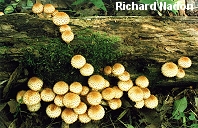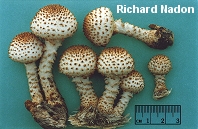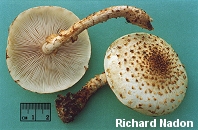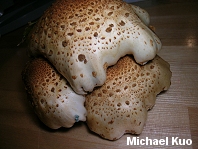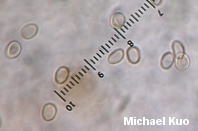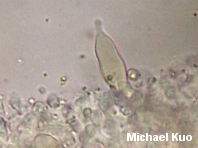| Major Groups > Gilled Mushrooms > Dark-Spored > Pholiota > Pholiota squarrosoides |

|
Pholiota squarrosoides [ Basidiomycetes > Agaricales > Strophariaceae > Pholiota . . . ] by Michael Kuo Theoretically, Pholiota squarrosoides can be separated from the very similar Pholiota squarrosa without the use of a microscope, since its gills go from whitish to rusty brown without passing through a greenish stage, and its cap is often slightly sticky underneath the scales (as opposed to the always-dry cap of Pholiota squarrosa). Additionally, Pholiota squarrosoides never develops the garlicky odor that some collections of Pholiota squarrosa develop. That's the theory, anyway--but as I'm sure you can imagine, weather conditions influence the stickiness of the cap and, if you have collected mature specimens, you have no way of knowing whether the gills passed through a greenish stage. And while some authors have attempted to provide other non-microscopic comparison points (for example, the colors of the cap surface and scales, or the degree of yellowishness displayed in the young gills), most of these features are variable and overlap considerably between the two species. Ultimately, microscopic analysis may be required to separate these mushrooms; Pholiota squarrosoides has substantially smaller spores than its look-alike (4-6 x 2.5-3.5 µ versus 6-8 x 4-5 µ), its spores lack an apical pore, and its cystidia lack the refractive contents found in the cystidia of Pholiota squarrosa. If you are thinking that two "species" separated on minor differences in their morphology should be seen as tentative I would be inclined to agree with you--if mating studies (Jacobsson, 1989; Klan and collaborators, 1989) and DNA analysis (Moncalvo and collaborators, 2002) had not supported their separation as biological and genetic species. Description: Ecology: Saprobic and possibly parasitic; growing in clusters (rarely alone or scattered) on the wood of hardwoods; summer and fall; fairly widely distributed in North America. Cap: 3-11 cm; convex, becoming broadly convex or broadly bell-shaped; usually sticky; whitish underneath conspicuous tawny scales. Gills: Attached to the stem or beginning to run down it; close or crowded; whitish, becoming rusty brown; at first covered by a partial veil. Stem: 4-10 cm long; up to 1.5 cm thick; dry; with an ephemeral ring or ring zone; whitish, sometimes becoming reddish brown near the base; covered with conspicuous tawny scales. Flesh: Whitish. Odor and Taste: Odor not distinctive or somewhat fragrant; taste not distinctive. Chemical Reactions: KOH negative on cap surface. Spore Print: Cinnamon brown. Microscopic Features: Spores 4-6 x 2.5-3.5 µ; smooth; more or less elliptical; lacking an apical pore; dull reddish brown in KOH. Pleurocystidia clavate to clavate-mucronate or fusoid-ventricose; lacking refractive contents in KOH; to 65 x 18 µ. Cheilocystidia mucronate, fusoid-ventricose or clavate; to 50 x 13 µ. Pileipellis partially gelatinized. Clamp connections present. REFERENCES: (Peck, 1879) Saccardo, 1887. (Saccardo, 1887; Kauffman, 1918; Overholts, 1927; Smith & Hesler, 1968; Smith, 1975; Smith, Smith & Weber, 1979; Scates & Gospodnetich, 1981/2003; Jacobsson, 1989; Klan et al., 1989; Phillips, 1991/2005; Lincoff, 1992; Barron, 1999; Roody, 2003; McNeil, 2006; Miller & Miller, 2006.) Herb. Kuo 09140703. Further Online Information: Pholiota squarrosoides in Smith & Hesler (1968) |
© MushroomExpert.Com |
|
Cite this page as: Kuo, M. (2007, November). Pholiota squarrosoides. Retrieved from the MushroomExpert.Com Web site: http://www.mushroomexpert.com/pholiota_squarrosoides.html |
